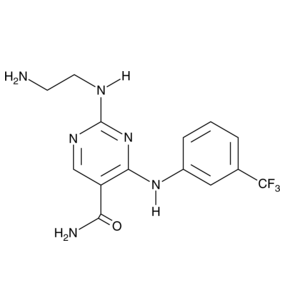| Cas No.: | 726695-51-8 |
| Chemical Name: | 2-[(2-aminoethyl)amino]-4-[[3-(trifluoromethyl)phenyl]amino]-5-pyrimidinecarboxamide |
| SMILES: | O=C(C1=CN=C(NCCN)N=C1NC2=CC=CC(C(F)(F)F)=C2)N |
| Formula: | C14H15F3N6O |
| M.Wt: | 340.30 |
| Purity: | >98% |
| Sotrage: | 2 years -20°C Powder, 2 weeks 4°C in DMSO, 6 months -80°C in DMSO |
| Description: | Syk Inhibitor II is a potent, high selective and ATP-competitive Syk inhibitor with an IC50 of 41 nM. Syk Inhibitor II inhibits 5-HT release from RBL-cells with an IC50 of 460 nM. Syk Inhibitor II shows less potent against other kinases and has anti-allergic effect[1]. |
| Target: | serotonin:460 nM (IC50) Syk:41 nM (IC50) PKCε:5.1 μM (IC50) PKCβ2:11 μM (IC50) ZAP-70:11.2 μM (IC50) Btk:15.5 μM (IC50) Itk:22.6 μM (IC50) |
| In Vivo: | Syk Inhibitor II (Compound 9a; 10-100 mg/kg) is subcutaneously administered to mice 30 min before antigen challenge. Syk Inhibitor II inhibits the anaphylaxis reaction dose-dependently with an ID50 value of 13.2 mg/kg[1]. |
| In Vitro: | Syk Inhibitor II (compound 9a) shows less potent against PKCε, PKCβ2, ZAP-70, Btk, and Itk with IC50 values of 5.1 µM, 11 µM, 11.2 µM, 15.5 µM, and 22.6 µM, respectively[1]. |
| References: | [1]. Hiroyuki Hisamichi, et al. Synthetic studies on novel Syk inhibitors. Part 1: Synthesis and structure-activity relationships of pyrimidine-5-carboxamide derivatives. Bioorg Med Chem. 2005 Aug 15;13(16):4936-51. |

 DC Chemicals' products qualify for U.S. tariff exemptions. We guarantee no price increases due to customs duties and maintain stable supply, continuing to deliver reliable research solutions to our American clients.
DC Chemicals' products qualify for U.S. tariff exemptions. We guarantee no price increases due to customs duties and maintain stable supply, continuing to deliver reliable research solutions to our American clients.





















